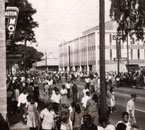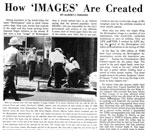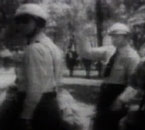The broadcasting and publication of the images of racial violence in Birmingham, Alabama in the spring of 1963 represented a turning point in the civil rights movement. The Reverend Fred L. Shuttlesworth, at the behest of the Alabama Christian Movement for Human Rights, a local civil rights group, invited Martin Luther King, Jr., and his colleagues in the Southern Christian Leadership Conference to help organize a campaign of boycotts and demonstrations to defy Birmingham’s harsh segregation laws. Along with the local African American community, King and his associates helped transform the fledgling Birmingham campaign into a striking spectacle, a continuum of gripping visual images building in intensity. Crusade leaders relied on the work of photojournalists, from within and outside the movement, to capture and disseminate riveting images.
As circumstances grew more heated, images of nonviolent civilians interacting with white police officers—graphic shots and footage of black protesters being attacked by dogs, beaten with clubs, and hosed down with high-pressure water jets—appeared in a broad range of media outlets. In the months following this widespread coverage, national public opinion surveys reported an increase in white Americans’ support of civil rights. This section explores how the media’s approach to these images resulted in multiple and at times contradictory stories, each designed to report, offer evidence, or persuade.
Image Credits/Captions (Click on thumbnails for full image)
Unidentified Photographer. [Civil Rights Demonstration], May 3, 1963. Black-and-white Polaroid. 2 7/8 x 3 13/16 in. Collection of International Center of Photography. Gift of Brian Wallis, 2000, 990.2000. A participant or bystander shot this Polaroid on the most fateful and violent day of the month-long Birmingham campaign.
Albert C. Persons (author and photographer). “How Images Are Created,” The True Selma Story, Sex and Civil Rights, 1965. 11 x 17 in. Collection of Civil Rights Archive/CADVC-UMBC, Baltimore, MD. 2005.44. By the early 1960s, many white southerners charged that photographs of racial conflicts in the mainstream media were faked or that written explanations of them were riddled with inaccuracies or lies. In 1965, Albert C. Persons, managing editor of a small Alabama newspaper, offered this analysis of the coverage of Birmingham. He asserts that northern newspapers and magazines, chiefly Time and Life, engaged in unscrupulous picture editing, disregarding all but those photographs that appeared to support allegations of police brutality.
TV Still: Breakthrough in Birmingham, CBS News, 1963. Courtesy CBS News Archives. The modern movement embraced television, sooner and with greater intensity than any other political group, because they understood its ability to get through to the “huge camp of the uncommitted,” as the New York Times noted in 1963, and thus to shift national sentiment toward their cause. Civil rights organizations mastered the medium—from the rigorous timing and staging of protests to carefully planned news conferences, speeches, and public appearances. What the national movement wanted and achieved in Birmingham was the graphic, ongoing evidence of the brutality of segregationists without serious injury to black protestors. This clip from a 1963 CBS News documentary suggests the visual and sensory power of these images—pictures credited by Atlanta Constitution in 1964 with “creating a momentum forceful enough to push the Civil Rights Act through Congress.”


